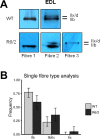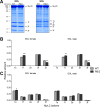Fast-to-Slow Transition of Skeletal Muscle Contractile Function and Corresponding Changes in Myosin Heavy and Light Chain Formation in the R6/2 Mouse Model of Huntington's Disease
- PMID: 27820862
- PMCID: PMC5098792
- DOI: 10.1371/journal.pone.0166106
Fast-to-Slow Transition of Skeletal Muscle Contractile Function and Corresponding Changes in Myosin Heavy and Light Chain Formation in the R6/2 Mouse Model of Huntington's Disease
Abstract
Huntington´s disease (HD) is a hereditary neurodegenerative disease resulting from an expanded polyglutamine sequence (poly-Q) in the protein huntingtin (HTT). Various studies report atrophy and metabolic pathology of skeletal muscle in HD and suggest as part of the process a fast-to-slow fiber type transition that may be caused by the pathological changes in central motor control or/and by mutant HTT in the muscle tissue itself. To investigate muscle pathology in HD, we used R6/2 mice, a common animal model for a rapidly progressing variant of the disease expressing exon 1 of the mutant human gene. We investigated alterations in the extensor digitorum longus (EDL), a typical fast-twitch muscle, and the soleus (SOL), a slow-twitch muscle. We focussed on mechanographic measurements of excised muscles using single and repetitive electrical stimulation and on the expression of the various myosin isoforms (heavy and light chains) using dodecyl sulfate polyacrylamide gel electrophoresis (SDS-PAGE) of whole muscle and single fiber preparations. In EDL of R6/2, the functional tests showed a left shift of the force-frequency relation and decrease in specific force. Moreover, the estimated relative contribution of the fastest myosin isoform MyHC IIb decreased, whereas the contribution of the slower MyHC IIx isoform increased. An additional change occurred in the alkali MyLC forms showing a decrease in 3f and an increase in 1f level. In SOL, a shift from fast MyHC IIa to the slow isoform I was detectable in male R6/2 mice only, and there was no evidence of isoform interconversion in the MyLC pattern. These alterations point to a partial remodeling of the contractile apparatus of R6/2 mice towards a slower contractile phenotype, predominantly in fast glycolytic fibers.
Conflict of interest statement
The authors have declared that no competing interests exist.
Figures




References
-
- Walker FO. Huntington's disease. The Lancet 2007; 369(9557):218–28. - PubMed
MeSH terms
Substances
LinkOut - more resources
Full Text Sources
Other Literature Sources
Medical
Molecular Biology Databases

